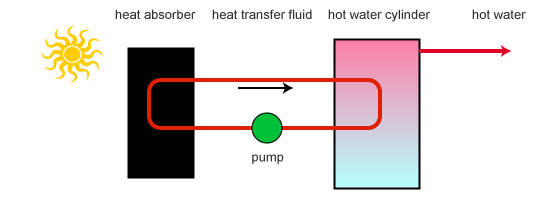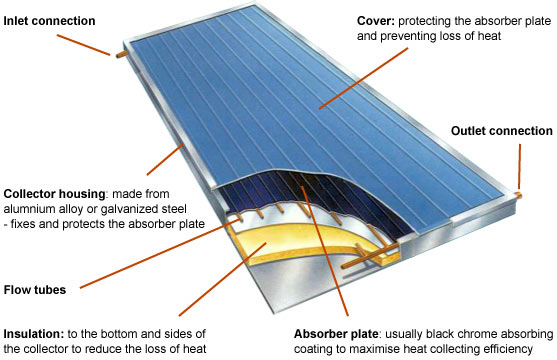INSTANT QUOTATION FOR A TYPICAL SIZED PROPERTY |
Click on the size of your property below to see the costs and benefits instantly |
|
| |
SOLAR THERMAL SYSTEMS |
Here at Ecotec Solar Energy Ltd, we take advantage of the latest technology to provide proven solar hot water solutions that are tailored to the individual requirements of each home.
Solar power and the environment
Fuelled by our emissions of CO2 and other greenhouse gases, planet Earth is warming up. In the UK, eight of the nine hottest year ever have been recorded since 1989! |
|
 |
|
Furthermore, energy prices have risen dramatically. In 2008, the average domestic gas bill was an astonishing 93% higher than in 2000. |
 |
Solar collector technology |
A solar water heating system has as its main component a collector. The function of the collector is to capture the sun’s energy falling on it in the form of heat to the fluid in the collector. The 'indirect' circulation system is the most common:
 |
The main common component of solar collectors is the absorber plate. A coated metal plate absorbs the sun’s radiation and causes its temperature to rise above the ambient. The plate then releases energy through radiation and convection to its immediate surroundings. Heat is thus transferred to the heat-transfer fluid which in turn feeds the hot water system.
|
| |
Types of collector: two general categories
Flat plate collectors |
 |
A flat-plate collector consists of an absorber, a transparent cover, a frame, and insulation. Usually an iron-poor solar safety glass is used as a transparent cover, as it transmits a great amount of the short-wave light spectrum.
Only very little of the heat emitted by the absorber escapes the cover (greenhouse effect).
In addition, the transparent cover prevents wind and breezes from carrying the collected heat away (convection). Together with the frame, the cover protects the absorber from adverse weather conditions. Typical frame materials include aluminium and galvanized steel; sometimes fibreglass-reinforced plastic is used.
The insulation on the back of the absorber and on the side-walls lessens the heat loss through conduction. Insulation is usually of polyurethane foam or mineral wool.
|
Evacuated-tube collectors |
 |
In this type of vacuum collector, the absorber strip is located in an evacuated and pressure proof glass tube. The heat transfer fluid flows through the absorber directly in a U-tube or in counter-current in a tube-in-tube system. Several single tubes, serially interconnected, or tubes connected to each other via manifold, make up the solar collector. A heat pipe collector incorporates a special fluid which begins to vaporize even at low temperatures. The steam rises in the individual heat pipes and warms up the carrier fluid in the main pipe by means of a heat exchanger. The condensed liquid then flows back into the base of the heat pipe.
The pipes must be angled at a specific degree above horizontal so that the process of vaporizing and condensing functions. There are two types of collector connection to the solar circulation system. Either the heat exchanger extends directly into the manifold ("wet connection") or it is connected to the manifold by a heat-conducting material ("dry connection"). A "dry connection" allows to exchange individual tubes without emptying the entire system of its fluid. Evacuted tubes offer the advantage that they work efficiently with high absorber temperatures and with low radiation. |
| |
Flat plate v Evacuated tube |
The debate over the relative performances of flat plate and evacuated tube collectors rumbles-on - without either side seemingly able to deliver the 'killer' argument.
In general though, it is probably safe to say that for a given absorber area, evacuated tubes are more likely to maintain their efficiency over a wide range of ambient termperatures and heating requirements. In constantly sunny climates flat plate collectors are more efficient whereas in more cloudy conditions their energy output drops off rapidly in comparison with evacuated tubes. |
| |
Heat distribution
|
Solar heating primary circuits transfer heat from the solar collectors to the pre-heat cylinder. They may be ‘Direct’ or, in the UK, the more usual ‘Indirect’. |
| |
'Direct' |
 |
Simplicity and increased efficiency over secondary circuits, through reduction of heat transfer loss. |
 |
Subject to freezing unless the water is drained-back when the pump switches off, which puts constraints on the positioning of the collectors in relation to the feed tank. |
 |
As new water continually flows through the collectors, they can be prone to ‘furring’ in the collector waterways resulting in loss of efficiency. |
|
| |
'Indirect' |
| |
Most circulation systems in the UK are indirect. Indirect circuits use a separate ‘heat-transfer fluid’ circuit to transfer heat from the collectors to the pre-heat cylinder. Their main advantage is that they can employ a wide range of materials and fluids as part of the circulation. There are different types of circulation that can be used:
|
| |
Circulation Systems for 'Indirect' distribution |
Passive circulation (aka ‘Gravity circulation’)
|
Passive systems rely on gravity and the tendency for water to naturally circulate as it is heated, allowing water or heat-transfer fluid to move through the system without pumps. Because they contain no electric components, passive systems are generally more reliable, easier to maintain, and possibly longer-lasting than active systems.
|
| |
|
 |
Electrical-powered pumps are not required to circulate the heat-transfer fluid. |
 |
Careful planning is needed to optimise performance. Systems are prone to sluggish performance and there is a poor control of heating. |
 |
Hot water storage tank needs locating above the collector level. |
|
 |
| |
Active circulation (aka ‘Pumped circulation’)
|
Pumped indirect circuits, incorporating a heat-transfer fluid including anti-freeze and corrosion inhibitor, are the most popular type of system in the UK.
The pump, controlled by a differential temperature controller, circulates the heat-transfer fluid from the collector panels through the heat exchanger in the hot water cylinder and back to the solar collectors for re-heating. The temperature sensors of the differential temperature controller are situated at the solar collector and on the hot water cylinder. They ensure that fluid is only circulated when the fluid in the collectors is hotter than in the cylinder.
|
| |
|
 |
Integral protection against freezing |
 |
Overheat control |
 |
Heat is delivered from the collector at optimal rate |
 |
Greater choice of collector and pipe layout |
 |
Reduces heat loss through pipes |
 |
Increased complexity |
 |
Pump requires electricity (though this can be alleviated by PV supply) |
 |
More expensive |
|
| |
Storage tank configurations |
The pre-heat configuration for the typical solar water heating system can be achieved in two ways, a separate pre-heat cylinder may be placed between existing cold water feed and the normal hot water storage, or the existing hot water storage cylinder can be replaced with a larger double heat exchange coil cylinder. Whichever design is chosen, extra storage volume is required. The space available to accommodate this extra storage capacity will often be the determining factor in the choice of system and also in the location of the storage cylinder. |
| |
|
| |
Ecotec Green Heating Ltd
147, London Road, St. Albans, Herts. AL1 1TA
Phone Number 01727 842658
Phone Number 01582 842158 |
VAT Number GB 327 7477 10
Registration Number: 6742853
e-mail: ecotec.green@btinternet.com
www.ecotecgreenheating.com |
| |
|
|